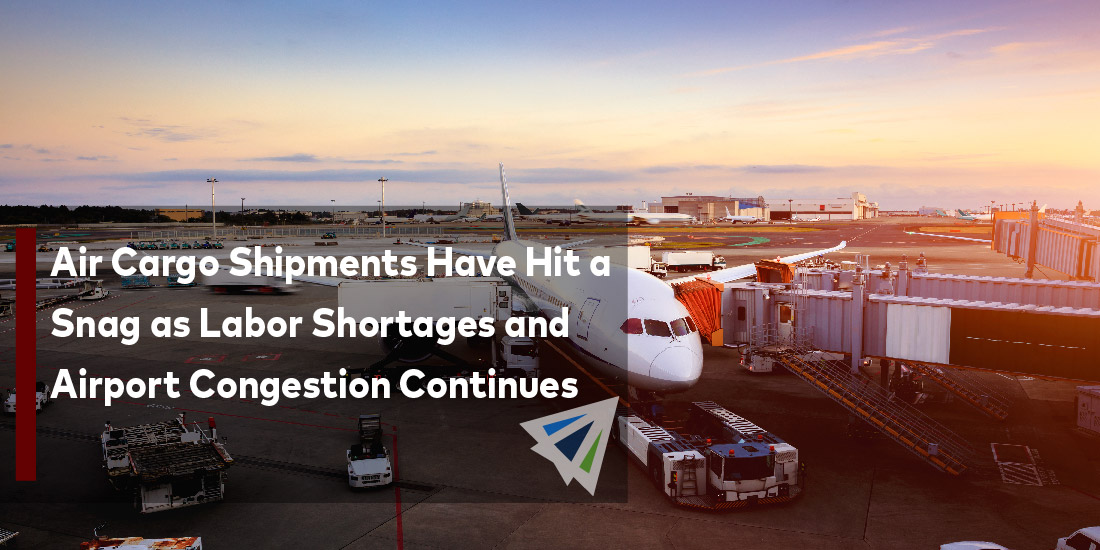Air Cargo Shipments Have Hit a Snag as Labor Shortages and Airport Congestion Continues
It’s usually the ocean shipping industry that’s faced with problems when major congestion, rate increases, and capacity issues arise. However, recent international shipping reports indicate that air shipments are hitting a snag amidst ongoing labor shortages and increased airport congestion.
The air industry saw volume weaken during the fourth quarter of 2021, an incredibly uncommon occurrence as the last several weeks of the year are usually a season of growth amidst the busy holiday months. Due to the increased contagiousness of the Omicron variant, COVID adversely impacted crew availability and decreased passenger air travel. In return, this has caused a major impact for TSA Known Shipper air cargo.
But despite all these bottlenecks to industry efficiency, demand continues to surge for cargo capacity. As a result, airfreight rates are rising from their January low back to the levels seen in December during the holiday season.
Generally speaking, air cargo seems to be the “safe bet” for shippers trying to move their cargo quickly. But according to World ACD, a cargo data publisher, airfreight volumes dropped 21% in the last week of December 2021.
Passenger Aircraft
Much of the congestion experienced has been a result of the decrease in passenger aircraft flights. However, this has been an ongoing issue since the start of the pandemic.
Passenger air travel saw the greatest dip in the earliest months of the pandemic which brought a great deal of air freight to a near standstill. However, as restrictions were lifted and shippers made necessary adjustments, air freight continued to move as originally planned.
The IATA reported this week that international passenger air travel was down by 60% from 2019 levels. While most are expecting passenger air travel to increase in the coming months, this doesn’t necessarily translate linearly to air cargo efficiency. The reason is that most air shippers have resorted to using cargo-only aircraft for their shipments considering the volatility of the passenger aircraft market.
The gist of these reports is that, while passenger air travel will steadily increase, shippers should not expect to see an immediate adjustment to air cargo congestions. That said, current demand for cargo-only aircrafts will most likely remain for a while.
Airline Labor Shortages
What makes the current situation worse are the labor shortage being experienced by several airlines. Due to COVID outbreaks and quarantine rules in different parts of the world, air carriers around the globe are experiencing major drops in staff availability to handle the increased demand.
Cathay Pacific, a Hong Kong-based air carrier, operated its cargo fleet at roughly 70% of capacity last year due to quarantine rules. The air carrier recently reported this month that it has scaled all the way back to 20% functionality once local authorities raised the isolation period up to seven days.
These changes in restrictions in Hong Kong are forcing carriers who wish to do business there to change crews in Tokyo, Japan or Seoul, South Korea before arrival to North America. But these extra stops increase fuel costs, labor costs, and landing fees (which are already at an all-time high).
The Omicron variant is certainly putting undue pressure on airlines as they are forced to cancel flights due to sick staff and overall labor shortages. U.S. airlines have cancelled thousands of flights in the past several weeks due to both labor shortages from COVID as well as severe weather events.
Currently, the generally accepted word in the industry is that air cargo isn’t expected to look great through the entire first half of 2022. Demand remains at an all-time high, but capacity pressure is higher than ever, and relief isn’t expected to come any time soon. Shippers should continue planning far in advance and budgeting aggressively as they anticipate the upcoming challenges being faced in the airfreight industry.
Please reach to our team at InterlogUSA for more information or questions you have regarding your shipping situation. Also check out our weekly market updates to stay in the loop with news and developments across the shipping industry!
